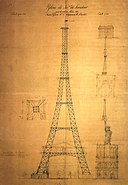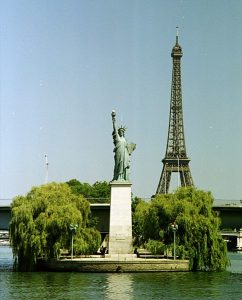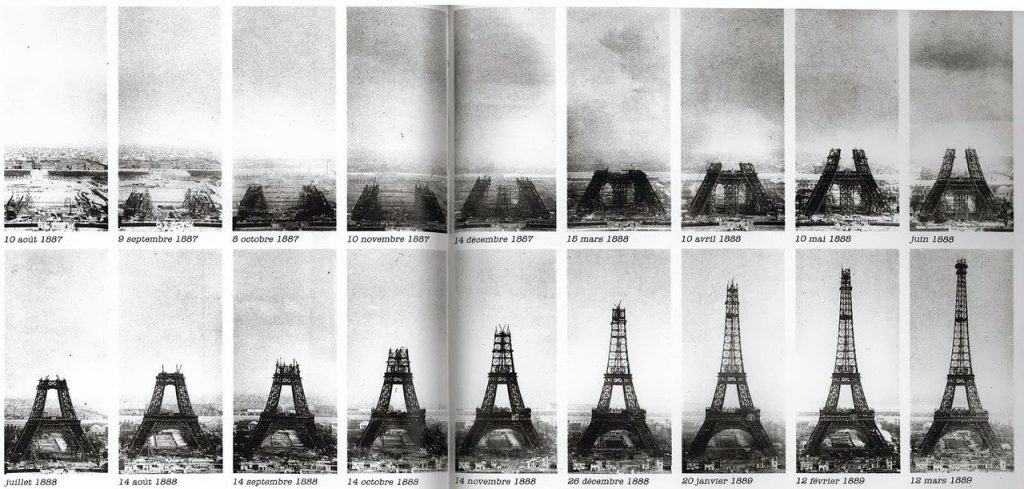|Eiffel Tower|
Facts about the Eiffel Tower : Did you know that many notable Parisians have decried the Eiffel Tower project ? Despite those protests, the Eiffel Tower became the Parisienne icon by Excellence. Indeed, it had a significant role in French history and sciences too (meteorology, aerodynamics, wind pressure, solar spectrum study, broadcasting…) up to nowadays.
Facts about the Eiffel Tower : its inventors
Organizers of the 1889 Exposition Universelle (World’s Fair) staged an open competition to design a spectacular centerpiece to their world’s fair. Out of 107 proposals, they selected the design submitted by Eiffel along with architect Stephen Sauvestre and engineers Maurice Koechlin plus Emile Nouguier.
During the 1889 Exposition Universelle, it was also about commemorated the 100-year anniversary of the French Revolution,
Maurice Koechlin and Emile Nouguier
In May 1884, 2 principal engineers of the Gustave Eiffel company are consulted to seek an idea for the Paris Universal Exhibition of 1889.
Émile Nouguier has been working for the Eiffel company for 10 years. He is a steel construction veteran.
Maurice Koechlin is younger. Eiffel hired Koechlin in 1879 a brilliant engineer, from the Polytechnicum in Zurich, to do Garabit’s calculations and run the firm’s design office. Koechlin returns home, does a crude calculation, and draws a sketch dated June 6, 1884, showing a gigantic three-hundred-meter-high metal pylon, directly inspired by bridge piers. The curved shape of the piles is designed to make this tower more wind resistant.
Gustave Eiffel authorized the 2 engineers to continue the study. He added the architect Sylvain Sauvestre in charge to liven up the decorative element. The final project would be the 14th draft since the one initiated by Nouguier and Koechlin. It took 700 drawings, 3,600 drawings of the 18,000 pieces by around 40 engineers designers.
The Eiffel Tower is a wrought-iron lattice tower on the Champ de Mars in Paris. The assembly of the supports began on July 1, 1887 and was completed twenty-two months later. Constructed from 1887 to 1889 for the 1889 World’s Fair, it was initially very much criticized by some of France’s leading artists and intellectuals for its design. However, it has become a global cultural icon of France and one of the most recognizable icon in the world. The Eiffel Tower was inaugurated on March 31, 1889, as a preview of the Universal Exhibition in Paris, which commemorates the centenary of the French Revolution.

Koechlin’s first drawing for the Eiffel Tower
Named after Gustave Eiffel
It is named after the engineer Gustave Eiffel (1832-1923), whose company designed and built the tower. Gustave Eiffel (1832-1923) founded and developed a company specializing in metal structural work. The Eiffel Tower was his best achievement among many others.

When the initial designer of the Statue of Liberty’s interior elements died suddenly in 1879, French sculptor Frederic-Auguste Bartholdi hired Gustave Eiffel for his replacement. Already renowned as a structural engineer and railway bridge designer, Gustave Eiffel designed the skeletal support system to which the statue’s copper skin is affixed. On the artificial island of Swans located on the Seine, in Paris stands a replica of the Statue of Liberty since 1889, 3 years after the installation of the Statue of Liberty in New York.
He devoted the last thirty years of his life to his experimental research by using the Eiffel Tower in wind resistance research, as a meteorological observation post, and as an aerial mast for the new science of radio broadcasting at that time.
Fact : Most visited paid monument in the world
The Eiffel Tower is the most-visited paid monument in the world; 6.91 million people ascended it in 2015. The tower is 324 metres (1,063 ft) tall, about the same height as an 81-storey building, and the tallest structure in Paris. Its base is square, measuring 125 metres (410 ft) on each side. It was the first structure in the world to reach a height of 300 metres (984 ft) in 1889.
The tower has three levels for visitors, with bistro, restaurants and souvenir boutiques.
- The first floor of the Eiffel Tower is the home of an exceptional brasserie.
- The Jules Verne restaurant is a gastronomic restaurant on the second floor with Frédéric Anton, a Michelin-starred chef, and his brilliant team. Reservation month ahead are mandatory.
- At the top of the Eiffel Tower, the Champagne Bar gives you the chance to enjoy a glass of champagne while taking in incredible views of Paris, seen from an altitude of 276m.
The climb from ground level to the first level is over 300 steps, as is the climb from the first level to the second. Although there is a staircase to the top level, it is usually accessible only by lift. While the Tower’s stairs have a total of 1,665 steps to go from the ground to the top of the Tower, you can only climb the 674 steps of the stairs from the ground to the 2nd floor (327, then 347 steps).
Other facts about the Eiffel tower : Colors
In fashionable Paris, even the Eiffel Tower must keep up with style trends. Over the decades, the “Iron Lady” has changed her looks with the application of a spectrum of paint colors. When it opened in 1889, the Eiffel Tower sported a reddish-brown color.
A decade later, it was coated in yellow paint. The tower was also yellow-brown and chestnut brown before the adoption of the current, specially mixed “Eiffel Tower Brown” in 1968. Every seven years, painters apply 60 tons of paint to the tower to keep her looking young. The tower is painted in three shades, progressively lighter with elevation, in order to augment the structure’s silhouette against the canvas of the Parisian sky.

The tower requires a fresh coat of paint every seven years to prevent rust. This keeps it looking pristine and protects the iron from the elements. Moreover, The Eiffel Tower lights up the Parisian night sky with 20,000 sparkling bulbs. Its nightly illuminations at sunset every hour for 5 minutes make it a beacon of light and romance. Indeed, it is embodying the nickname “The City of Lights.”
Fact : The Eiffel Tower was not supposed to last
Seeking a way to prove the structure’s strategic utility
Since Eiffel footed 80 percent of the tower’s construction costs, he was permitted to have the structure stand for 20 years. He could recoup his investment before it passed into the hands of the Parisian government. It was planned to disassemble it for scrap metal. Seeking a way to prove the structure’s strategic utility in a bid to save it, Eiffel erected an antenna atop the tower and financed experiments with wireless telegraphy that began in 1898. The value of the tower in sending and receiving wireless messages, particularly for the French military, caused the city to renew Eiffel’s concession when it expired in 1909.
Experiments and applications
The Eiffel Tower is a fantastic scientific support. Indeed, where else than in Paris stands a metal pylon more than 300m high, with such a mass? Such an object is inevitably a boon for scientists who, from its construction, took advantage of its size to carry out all the experiments they wanted to do. We must distinguish between experiments and applications. Experiments have only served to advance science (such as aerodynamics and wind pressure study). Applications have used the Eiffel Tower as a medium to provide special utility (such as telegraphy, radio and television broadcasting). Today, more than 100 antennae on the tower beam radio and television broadcasts around the world.
72 of the country’s scientists
Eiffel engraved the names of 72 of the country’s scientists in the tower’s first-level gallery. In addition, atop the structure he installed a laboratory that was used by himself. French scientists would study astronomy, meteorology, aerodynamics and physiology and test experiments such as Foucault’s Pendulum. In 1909, Eiffel installed an aerodynamic wind tunnel at the base of the tower. Indeed, it carried out thousands of tests, including those on Wright Brothers airplanes and Porsche automobiles.
Facts about the Eiffel Tower : Used by the Army
Facts about the Eiffel Tower during WWI
The Eiffel Tower then became a real military building, with an underground telecommunication room. It will allow communication with taxis in the Marne, and the United States. Moreover, it will even capture the Germans’ drafting message in 1918. When the First World War broke out in 1914, “the decision was taken to make the tower a military observation post and it was ordered to do everything possible to make the most of the enemy’s eavesdropping”.
Facts about the Eiffel Tower during WWII
During the Second World War, the occupation by the Germans of the Eiffel Tower, symbol of France, rhymed with victory. In 1944, the tower escaped the promised destruction. In August, a French flag flew there again, the elevators were restarted. However, it was still not reopened to the general public. The American troops set up their Transmission service on the third floor. It was ensuring communications between the Channel ports, England and the Allied troops stationed around Paris. They reserved entry to Allied soldiers in uniform for a free visit. Finally, the monument will be accessible to the public again from June 1946.
Hope you enjoy those facts about the Eiffel Tower. Have a private tour in the Eiffel Tower area.
Emy,

